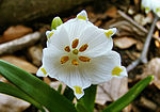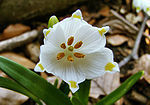
Starczanowo, Poznan County
Encyclopedia
Starczanowo s is a village
in the administrative district of Gmina Murowana Goślina
, within Poznań County
, Greater Poland Voivodeship
, in west-central Poland. It lies approximately 6 kilometres (4 mi) north-west of Murowana Goślina
and 23 km (14 mi) north of the regional capital Poznań
. It was first mentioned in written records in 1364. It has an approximate population of 50.
About 1 km east of the village is the site of Radzim, formerly a fortress and castellany
on an island (now a peninsula) in the Warta river (first mentioned 1254). This was an important centre in the Piast kingdom, lying on a route between Gniezno
and western Pomerania
. However the castellany ceased to exist in the second half of the fifteenth century, and the remaining village of Radzim declined in the 18th century as a result of the Swedish invasions, finally being wiped out by cholera in the early 19th century. No buildings survive, but achitectural work has been carried out on the site.
A little further north along the Warta is the Śnieżycowy Jar nature reserve
, founded in 1975 and now covering 9 hectare
s. It is most notable for the large numbers of spring snowflakes (Leucojum vernum) which bloom in late February and early March. This is one of the few places where this flower is found in lowland Poland. It is thought to have been brought here by human intervention in the 19th century.

Village
A village is a clustered human settlement or community, larger than a hamlet with the population ranging from a few hundred to a few thousand , Though often located in rural areas, the term urban village is also applied to certain urban neighbourhoods, such as the West Village in Manhattan, New...
in the administrative district of Gmina Murowana Goślina
Gmina Murowana Goslina
Gmina Murowana Goślina is an urban-rural gmina in Poznań County, Greater Poland Voivodeship, in west-central Poland. Its seat is the town of Murowana Goślina, which lies approximately north of the regional capital Poznań. The gmina consists of Murowana Goślina and the countryside and villages...
, within Poznań County
Poznan County
Poznań County is a unit of territorial administration and local government in Greater Poland Voivodeship, west-central Poland. It came into being on January 1, 1999, as a result of the Polish local government reforms passed in 1998. Its administrative seat is the city of Poznań, although the city...
, Greater Poland Voivodeship
Greater Poland Voivodeship
Wielkopolska Voivodeship , or Greater Poland Voivodeship, is a voivodeship, or province, in west-central Poland. It was created on 1 January 1999 out of the former Poznań, Kalisz, Konin, Piła and Leszno Voivodeships, pursuant to the Polish local government reforms adopted in 1998...
, in west-central Poland. It lies approximately 6 kilometres (4 mi) north-west of Murowana Goślina
Murowana Goslina
Murowana Goślina is a town in Poznań County in western Poland, with 10,336 inhabitants . It lies approximately north of the major city of Poznań, on the main road and railway line to Wągrowiec...
and 23 km (14 mi) north of the regional capital Poznań
Poznan
Poznań is a city on the Warta river in west-central Poland, with a population of 556,022 in June 2009. It is among the oldest cities in Poland, and was one of the most important centres in the early Polish state, whose first rulers were buried at Poznań's cathedral. It is sometimes claimed to be...
. It was first mentioned in written records in 1364. It has an approximate population of 50.
About 1 km east of the village is the site of Radzim, formerly a fortress and castellany
Castellany
A castellany was a district administered by a castellan.Castellanies appeared during the Middle Ages and in most current states are now replaced by a more modern type of country subdivision....
on an island (now a peninsula) in the Warta river (first mentioned 1254). This was an important centre in the Piast kingdom, lying on a route between Gniezno
Gniezno
Gniezno is a city in central-western Poland, some 50 km east of Poznań, inhabited by about 70,000 people. One of the Piasts' chief cities, it was mentioned by 10th century A.D. sources as the capital of Piast Poland however the first capital of Piast realm was most likely Giecz built around...
and western Pomerania
Pomerania
Pomerania is a historical region on the south shore of the Baltic Sea. Divided between Germany and Poland, it stretches roughly from the Recknitz River near Stralsund in the West, via the Oder River delta near Szczecin, to the mouth of the Vistula River near Gdańsk in the East...
. However the castellany ceased to exist in the second half of the fifteenth century, and the remaining village of Radzim declined in the 18th century as a result of the Swedish invasions, finally being wiped out by cholera in the early 19th century. No buildings survive, but achitectural work has been carried out on the site.
A little further north along the Warta is the Śnieżycowy Jar nature reserve
Nature reserve
A nature reserve is a protected area of importance for wildlife, flora, fauna or features of geological or other special interest, which is reserved and managed for conservation and to provide special opportunities for study or research...
, founded in 1975 and now covering 9 hectare
Hectare
The hectare is a metric unit of area defined as 10,000 square metres , and primarily used in the measurement of land. In 1795, when the metric system was introduced, the are was defined as being 100 square metres and the hectare was thus 100 ares or 1/100 km2...
s. It is most notable for the large numbers of spring snowflakes (Leucojum vernum) which bloom in late February and early March. This is one of the few places where this flower is found in lowland Poland. It is thought to have been brought here by human intervention in the 19th century.


